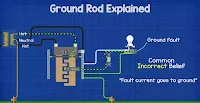The Function of Earthing Function is primarily used to avoid electric shocks, and Grounding is primarily used for unbalancing when the electric system
Grounding & Earthing Function
In plants generally all electrical systems are grounded to earth. This prevents electric shocks and accidental electrical discharge.
The Function of Earthing Function is primarily used to avoid electric shocks, and Grounding is primarily used for unbalancing when the electric system overloads. Earthing is located under the earth pit, between the equipment body and the underground pit. It is located between the neutral of the equipment being used and the ground.
At the power plant where alternating current is generated, or made, one of the wires of the AC line is connected to earth by a metal rod. The metal casings, or housings, of electrical devices are connected to this earth ground wire. Without the earth ground connection, a person touching the device might get a dangerous electric shock. When the AC current is grounded to earth, you will not get a shock if you touch the outside casings of electric motors and other electrical devices.Most of the direct current (DC) systems are also grounded to earth. Some DC circuits are grounded to the chassis, or housing, they are in. The chassis is then grounded to earth. The negative side of the voltage source is considered the grounded side.
The Main difference between Neutral, Ground and Earth?
To understand the difference between Neutral, Ground and Earth, we must first understand the purpose of these elements.Neutral
Neutral is the return path for electric current in an electric circuit which is intended to carry current in normal condition. This current may result from various factors, primarily due to phase current imbalances and occasionally as a result of the presence of 3rd and 5th harmonics.
The neutral wire provides a return path for the current to flow back to the power source, completing the circuit. In household wiring, it usually carries current from various electrical loads back to the electrical panel or distribution point.
In a properly functioning electrical system, the voltage on the neutral wire should be close to zero volts. It helps stabilize the voltage and maintain a relatively constant potential difference between the live (hot) and neutral wires.
The neutral wire is designed to carry current under normal operating conditions. If there is an imbalance between the current on the live (hot) wire and the neutral wire, it can indicate a fault or short circuit, which can be detected and used to shut off power for safety reasons.
There may be other reasons too but the magnitude of this current is in fraction of phase current and in few cases it can be even double of phase current. So Neutral wire is always assumed to be charged (in active circuit). This neutral wire is connected to the ground (by grounding as in a domestic power supply the Ground is bonded to Neutral, to provide a return path to the transformer at the sub-station) to make the second terminal of neutral wire at zero potential.
Earth or Ground
Earth or Ground is used for safety purposes to divert leakage or residual currents in the system through the path of least resistance. While Phase and Neutral are connected to the main power wiring, the earth may be connected to the body of equipment or to any system that, under normal conditions, doesn’t carry current. However, in case of insulation failure, it is designed to carry a minor current.
Due to differences in their applications, we never mix the grounding of Neutral and Earth. Nonetheless, both are grounded (although the methods may differ). If they were to be mixed, the earth wire, which is not supposed to carry any current under normal conditions, may accumulate charges and become a hazard
Difference Between Earthing & Grounding.
There is no difference between ‘Earthing’ and ‘Grounding‘; these terms are used interchangeably. Grounding, also known as Bonding, is the term commonly used for earthing in North American standards such as IEEE, NEC, ANSI, and UL, while Earthing is the term used in European, Commonwealth countries, and British standards such as IS and IEC.
In simple words, Earthing and Grounding are synonyms. Both are similar words used for the same thing,
- [accordion]
- 1. Grounding & Earthing Function
-
- 2. BS EN 62305-1-2011 Protection Against Lightning
- 3. IEC 60417-1-2000 Graphic Symbol for Equipment
- 4. IEC 60417-2-1998 + A1-2002 Graphic Symbol for Equipment
- 5. IEC 60417-SN-2009 Snapshot Database
- 6. IEC 62305-2-2010 Protection Lightning Risk Management
- 7. IEEE 30031.1-2019 RP System Grounding for Industrial
- 8. IEEE Std 367-2012 RP Determining the Electrical Power Station
- 9. Lightning Risk Assessment Calculation
- 10. NFPA 70, National Electrical Code, 2023
- 11. NFPA 731 Installation Electronic Security System
- 12. NFPA780 Standard Installation Lightning Protection
- 13. UL 467 2013 Grounding and Bonding Equipment
- 1. Grounding & Earthing Function
- 2. BS EN 62305-1-2011 Protection Against Lightning
- 3. IEC 60417-1-2000 Graphic Symbol for Equipment
- 4. IEC 60417-2-1998 + A1-2002 Graphic Symbol for Equipment
- 5. IEC 60417-SN-2009 Snapshot Database
- 6. IEC 62305-2-2010 Protection Lightning Risk Management
- 7. IEEE 30031.1-2019 RP System Grounding for Industrial
- 8. IEEE Std 367-2012 RP Determining the Electrical Power Station
- 9. Lightning Risk Assessment Calculation
- 10. NFPA 70, National Electrical Code, 2023
- 11. NFPA 731 Installation Electronic Security System
- 12. NFPA780 Standard Installation Lightning Protection
- 13. UL 467 2013 Grounding and Bonding Equipment









